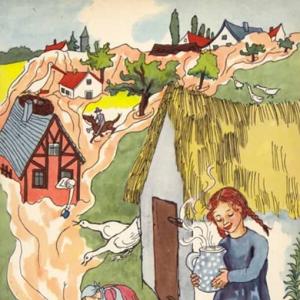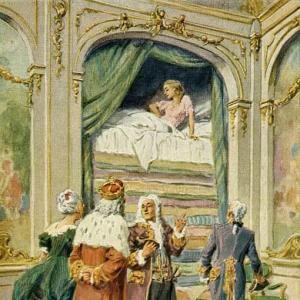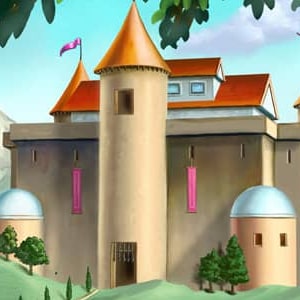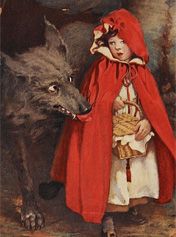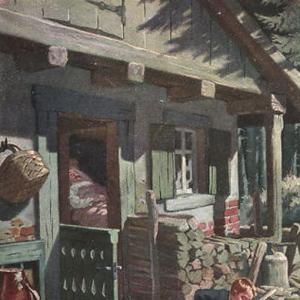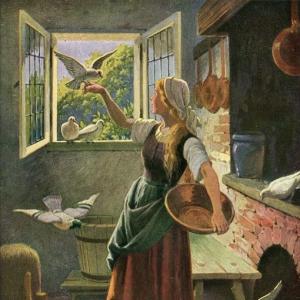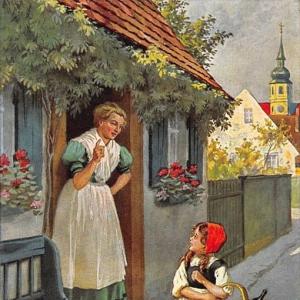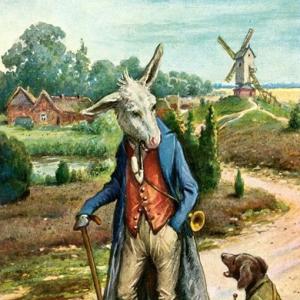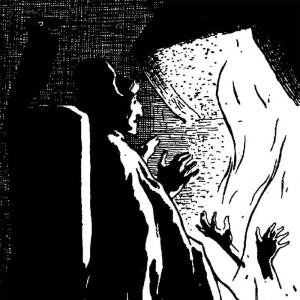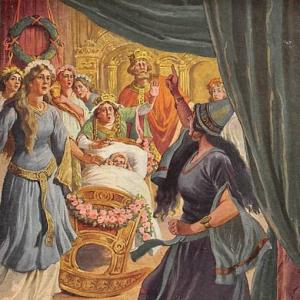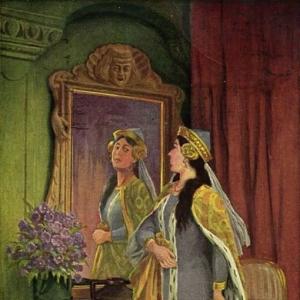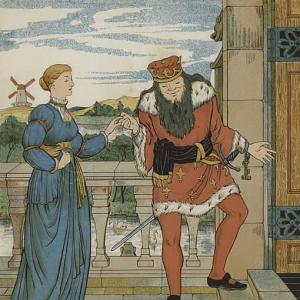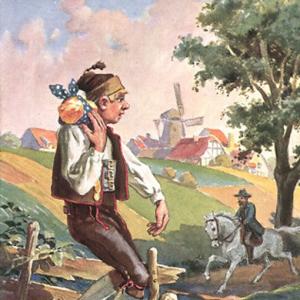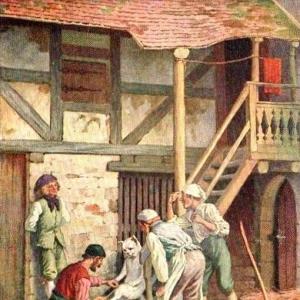Reading time for children: 11 min
There once lived a man and his wife, who had long wished for a child, but in vain. Now there was at the back of their house a little window which overlooked a beautiful garden full of the finest vegetables and flowers; but there was a high wall all round it, and no one ventured into it, for it belonged to a witch of great might, and of whom all the world was afraid.
One day that the wife was standing at the window, and looking into the garden, she saw a bed filled with the finest rampion; and it looked so fresh and green that she began to wish for some; and at length she longed for it greatly. This went on for days, and as she knew she could not get the rampion, she pined away, and grew pale and miserable. Then the man was uneasy, and asked, „What is the matter, dear wife?“
„Oh,“ answered she, „I shall die unless I can have some of that rampion to eat that grows in the garden at the back of our house.“ The man, who loved her very much, thought to himself, „Rather than lose my wife I will get some rampion, cost what it will.“ So in the twilight he climbed over the wall into the witch’s garden, plucked hastily a handful of rampion and brought it to his wife.
She made a salad of it at once, and ate of it to her heart’s content. But she liked it so much, and it tasted so good, that the next day she longed for it thrice as much as she had done before. If she was to have any rest the man must climb over the wall once more. So he went in the twilight again; and as he was climbing back, he saw, all at once, the witch standing before him, and was terribly frightened, as she cried, with angry eyes, „How dare you climb over into my garden like a thief, and steal my rampion! It shall be the worse for you!“
„Oh,“ answered he, „be merciful rather than just, I have only done it through necessity. For my wife saw your rampion out of the window, and became possessed with so great a longing that she would have died if she could not have had some to eat.“ Then the witch said, „If it is all as you say you may have as much rampion as you like, on one condition – the child that will come into the world must be given to me. It shall go well with the child, and I will care for it like a mother.“
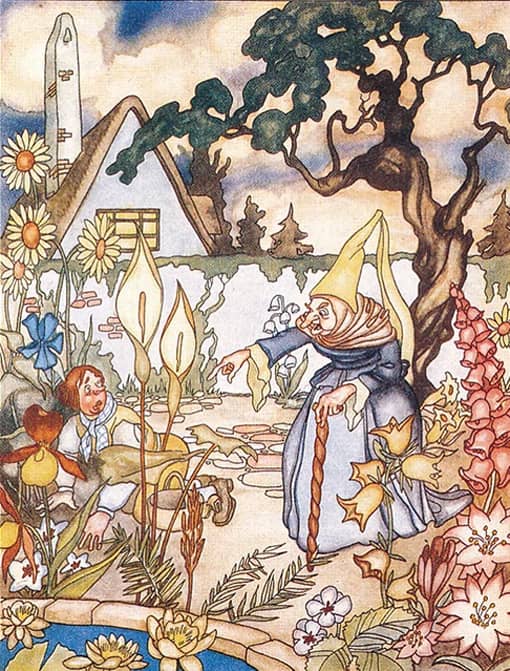
In his distress of mind the man promised everything; and when the time came when the child was born the witch appeared, and, giving the child the name of Rapunzel (which is the same as rampion), she took it away with her. Rapunzel was the most beautiful child in the world. When she was twelve years old the witch shut her up in a tower in the midst of a wood, and it had neither steps nor door, only a small window above. When the witch wished to be let in, she would stand below and would cry,
„Rapunzel, Rapunzel!
Let down your hair!“
Rapunzel had beautiful long hair that shone like gold. When she. heard the voice of the witch she would undo the fastening of the upper window, unbind the plaits of her hair, and let it down twenty ells below, and the witch would climb up by it.
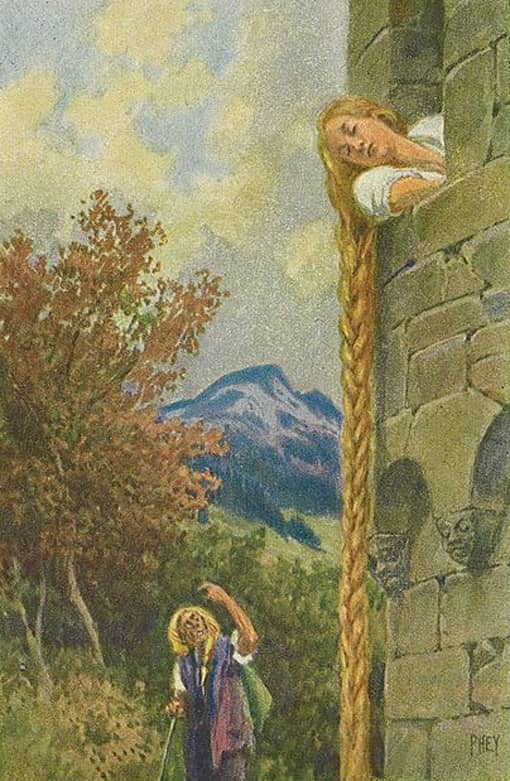 Image: Paul Hey (1867 – 1952)
Image: Paul Hey (1867 – 1952)After they had lived thus a few years it happened that as the King’s son was riding through the wood, he came to the tower; and as he drew near he heard a voice singing so sweetly that he stood still and listened. It was Rapunzel in her loneliness trying to pass away the time with sweet songs. The King’s son wished to go in to her, and sought to find a door in the tower, but there was none.
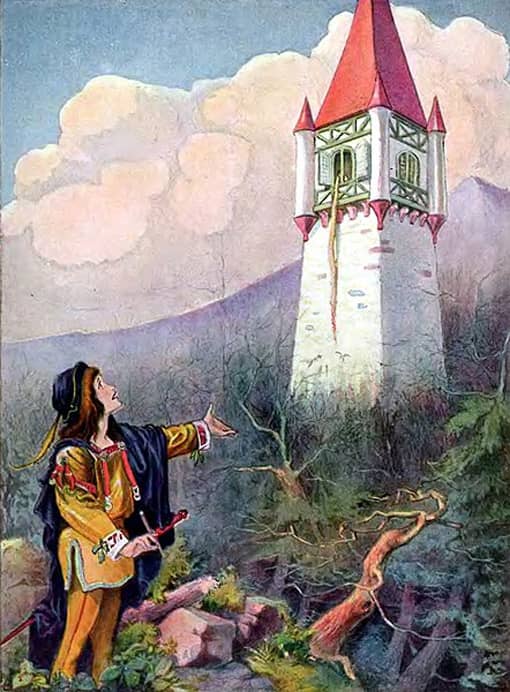
So he rode home, but the song had entered into his heart, and every day he went into the wood and listened to it. Once, as he was standing there under a tree, he saw the witch come up, and listened while she called out,
„O Rapunzel, Rapunzel!
Let down your hair.“
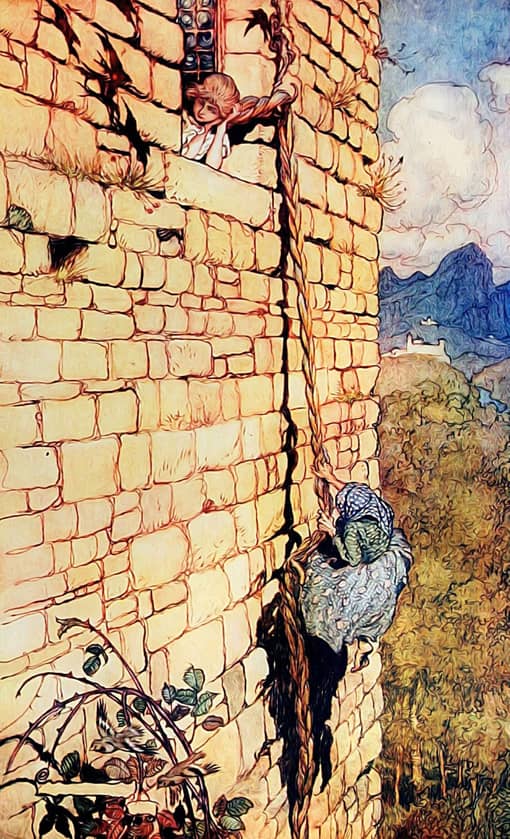
Then he saw how Rapunzel let down her long tresses, and how the witch climbed up by it and went in to her, and he said to himself, „Since that is the ladder I will climb it, and seek my fortune.“ And the next day, as soon as it began to grow dusk, he went to the tower and cried,
„O Rapunzel, Rapunzel! Let down your hair.“
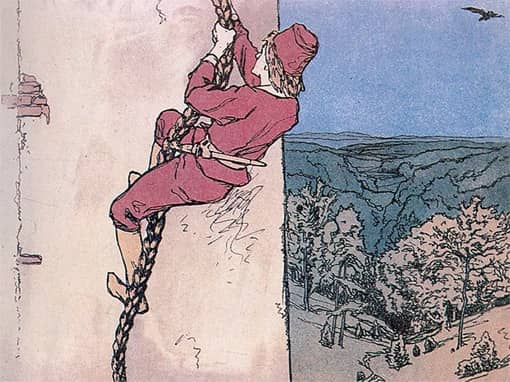
And she let down her hair, and the King’s son climbed up by it. Rapunzel was greatly terrified when she saw that a man had come in to her, for she had never seen one before; but the King’s son began speaking so kindly to her, and told how her singing had entered into his heart, so that he could have no peace until he had seen her herself. Then Rapunzel forgot her terror, and when he asked her to take him for her husband, and she saw that he was young and beautiful, she thought to herself, „I certainly like him much better than old mother Gothel,“ and she put her hand into his hand.
She said: „I would willingly go with thee, but I do not know how I shall get out. When thou comest, bring each time a silken rope, and I will make a ladder, and when it is quite ready I will get down by it out of the tower, and thou shalt take me away on thy horse.“ They agreed that he should come to her every evening, as the old woman came in the day-time. So the witch knew nothing of all this until once Rapunzel said to her unwittingly, „Mother Gothel, how is it that you climb up here so slowly, and the King’s son is with me in a moment?“
„O wicked child,“ cried the witch, „what is this I hear! I thought I had hidden thee from all the world, and thou hast betrayed me!“ In her anger she seized Rapunzel by her beautiful hair, struck her several times with her left hand, and then grasping a pair of shears in her right – snip, snap – the beautiful locks lay on the ground. And she was so hard-hearted that she took Rapunzel and put her in a waste and desert place, where she lived in great woe and misery.
The same day on which she took Rapunzel away she went back to the tower in the evening and made fast the severed locks of hair to the window-hasp, and the King’s son came and cried,
„Rapunzel, Rapunzel! Let down your hair.“
Then she let the hair down, and the King’s son climbed up, but instead of his dearest Rapunzel he found the witch looking at him with wicked glittering eyes. „Aha!“ cried she, mocking him, „you came for your darling, but the sweet bird sits no longer in the nest, and sings no more. The cat has got her, and will scratch out your eyes as well! Rapunzel is lost to you. You will see her no more.“
The King’s son was beside himself with grief, and in his agony he sprang from the tower: he escaped with life, but the thorns on which he fell put out his eyes. Then he wandered blind through the wood, eating nothing but roots and berries, and doing nothing but lament and weep for the loss of his dearest wife. So he wandered several years in misery until at last he came to the desert place where Rapunzel lived with her twin-children that she had borne, a boy and a girl.
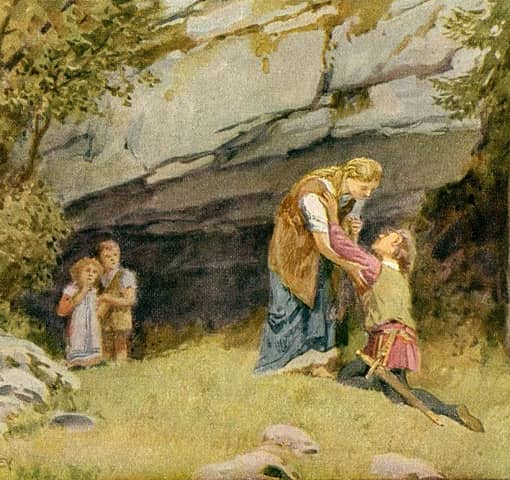 Image: Paul Hey (1867 – 1952)
Image: Paul Hey (1867 – 1952)At first he heard a voice that he thought he knew, and when he reached the place from which it seemed to come Rapunzel knew him, and fell on his neck and wept. And when her tears touched his eyes they became clear again, and he could see with them as well as ever. Then he took her to his kingdom, where he was received with great joy, and there they lived long and happily.
 Learn languages. Double-Tap on one word.Learn languages in context with Childstories.org and Deepl.com.
Learn languages. Double-Tap on one word.Learn languages in context with Childstories.org and Deepl.com.Backgrounds to fairy tale „Rapunzel“
„Rapunzel“ is a well-known fairy tale collected by the Brothers Grimm in their 1812 publication „Children’s and Household Tales“ (also known as „Grimm’s Fairy Tales“). The story has its roots in European folklore and oral tradition, with several variants existing across different cultures. The tale tells the story of a young girl named Rapunzel, who is locked away in a tower by an enchantress named Dame Gothel. Rapunzel has extraordinarily long hair, which she lets down from the tower window for the witch to climb up.
One day, a prince hears Rapunzel singing and discovers the tower. He begins to visit her secretly, using her hair as a ladder to climb up. Eventually, they fall in love and make plans to escape. However, the witch discovers their plan, cuts off Rapunzel’s hair, and banishes her to a distant desert. The prince, too, is punished when he falls from the tower and is blinded by thorns. After wandering for years, the prince and Rapunzel are eventually reunited, and her tears restore his sight. The couple returns to the prince’s kingdom, where they live happily ever after.
The story of Rapunzel can be traced back to earlier European folktales, such as the Italian story „Petrosinella“ by Giambattista Basile and the French tale „Persinette“ by Charlotte-Rose de Caumont de La Force. These earlier versions share common elements with the Brothers Grimm’s „Rapunzel,“ such as a girl locked in a tower, a prince, and the use of long hair as a means of escape.
The Brothers Grimm collected „Rapunzel“ and many other fairy tales as part of their broader project to document and preserve German folklore and oral traditions. Their work was a part of the Romantic movement in 19th-century Europe, which emphasized a return to traditional folk culture and a celebration of national identity. While the Brothers Grimm often made changes and edits to the stories they collected, their work remains an important resource for understanding the cultural and historical context of European fairy tales.
The Brothers Grimm, Jacob (1785-1863) and Wilhelm (1786-1859), were German academics and linguists who collected and published numerous folktales as part of their work in preserving and understanding the German cultural heritage. They aimed to create a comprehensive record of the oral storytelling tradition in Germany during their time. The Grimm brothers‘ work greatly influenced the study of folklore, and their tales have become iconic and widely recognized around the world. The „Rapunzel“ story likely has roots in earlier European tales, such as the Italian story „Petrosinella“ by Giambattista Basile, which was published in his 1634 work „Lo cunto de li cunti“ (The Tale of Tales). Another similar tale is the French story „Persinette“ by Charlotte-Rose de Caumont de La Force, published in 1698. Both of these stories involve a maiden with magical hair who is trapped in a tower by an enchantress.
Over time, the Rapunzel story has been adapted and retold in various forms, including books, plays, and movies. One popular modern adaptation is the 2010 Disney animated film „Tangled,“ which reimagines the tale with a contemporary twist, while still incorporating elements of the original story. The „Rapunzel“ fairy tale continues to capture the imaginations of readers and audiences, demonstrating its timeless appeal and its ability to resonate with themes of desire, love, and transformation.
Interpretations to fairy tale „Rapunzel“
„Rapunzel“ is a rich and layered fairy tale that can be interpreted in various ways. Some common interpretations of the story include:
Coming of age and self-discovery: Rapunzel’s journey from a confined life in the tower to her eventual freedom can be seen as a metaphor for personal growth and self-discovery. Her experiences and challenges, including her relationship with the prince, lead her to find her own identity and strength.
Feminine power and transformation: Rapunzel’s long, magical hair is a symbol of her power and potential. Although initially a means of her imprisonment, her hair ultimately becomes an instrument of her liberation. This can be seen as an allegory for the transformative power of feminine qualities, which can overcome adversity. Throughout the story, the characters undergo significant transformations. Rapunzel matures from a naive girl to a woman who experiences love, heartbreak, and motherhood. The prince, initially infatuated with Rapunzel’s singing, must learn to endure hardship and loss before reuniting with her. Their transformations lead to a stronger, deeper bond between them.
The power of love and redemption: The love between Rapunzel and the prince is a central theme of the story. Their devotion to one another leads them to overcome obstacles, including their separation and the prince’s blindness. The redemptive power of love is demonstrated when Rapunzel’s tears heal the prince’s sight, emphasizing the transformative potential of genuine love. Love is the central force that drives the prince and Rapunzel to overcome the obstacles in their path. Their love for each other empowers them to endure hardships and seek redemption. In the end, love has a healing and transformative power, as seen when Rapunzel’s tears restore the prince’s sight, and they live happily ever after.
Female confinement and societal expectations: The story can be read as a critique of the ways in which women have been historically confined and controlled by societal expectations. Rapunzel’s imprisonment in the tower by the witch symbolizes the limitations imposed on women in patriarchal societies. Her eventual escape and union with the prince can be seen as an assertion of her agency and a challenge to these traditional constraints.
Parental control and overprotection: The witch desire to keep Rapunzel locked away in the tower can be interpreted as a metaphor for overprotective parenting. This overbearing control stunts Rapunzel’s growth and independence. The story highlights the importance of allowing children to experience the world and develop their own sense of self. The witch represents power and control in the story. She controls Rapunzel’s life by locking her in a tower and later separating her from the prince. The witch’s power is challenged by the prince, who ultimately helps Rapunzel escape her imprisonment.
The triumph of good over evil: Like many fairy tales, „Rapunzel“ features a clear distinction between good and evil. Rapunzel and the prince represent goodness, while the witch embodies evil. The story ultimately sees good triumphing over evil, as Rapunzel and the prince are reunited and live happily ever after.
Desire and longing: The story begins with a couple’s deep desire for a child. The wife’s longing for rampion, which she believes will satisfy her, symbolizes this desire. The prince also experiences intense longing when he hears Rapunzel’s singing. This theme illustrates how desires can drive the characters‘ actions, often leading to unforeseen consequences.
Imprisonment and isolation: Rapunzel is locked in a tower by the witch, experiencing extreme isolation. This imprisonment is both physical and emotional, as Rapunzel is cut off from the world and human contact. Her isolation is further symbolized by the tower’s inaccessibility. The prince’s blindness also represents a form of imprisonment, as it restricts his ability to navigate the world.
These are just a few of the possible interpretations of „Rapunzel.“ As with all fairy tales, individual readers may find different meanings and messages within the story based on their own experiences and perspectives.
Adaptions of the fairy tale „Rapunzel“
„Rapunzel“ is a classic fairy tale that has been passed down through generations, with its origins tracing back to various European folklore sources. The best-known version is from the Brothers Grimm, who included it in their collection of German folktales titled „Kinder- und Hausmärchen“ (Children’s and Household Tales), first published in 1812. „Rapunzel“ is a popular fairy tale that has inspired numerous adaptations and retellings over the years. The fairy tale „Rapunzel“ has been adapted into various forms of media, including:
Films: „Tangled“ (2010): Disney’s animated feature film reimagines the story of Rapunzel, focusing on her journey of self-discovery and her relationship with Flynn Rider, a thief who helps her escape from the tower. The film adds humor, music, and a visually striking aesthetic, making it a family-friendly adaptation. This animated movie tells the story of Rapunzel in a modern, humorous way. It features a spunky and independent version of Rapunzel who escapes from her tower with the help of a thief named Flynn Rider. The film was a critical and commercial success and won several awards. „Barbie as Rapunzel“: This animated movie by Mattel tells the story of Rapunzel as a Barbie doll. The film features songs, romance, and a message about creativity and self-expression. „Rapunzel and the Seven Dwarfs“: This Russian animated film combines the stories of Rapunzel and Snow White. The film features a comedic take on the fairy tale, with Rapunzel being held captive by an evil queen who is obsessed with beauty.
Television: „Faerie Tale Theater“ (1982-1987): This live-action anthology series featured an episode titled „Rapunzel,“ starring Shelley Duvall as Rapunzel and Jeff Bridges as the prince. The show stayed true to the original story while also adding elements of humor and fantasy.
„Grimm’s Fairy Tale Classics“ (1987-1989): This Japanese animated series featured an episode retelling the story of Rapunzel, with a focus on staying true to the original Grimm Brothers‘ tale.
Books and retellings: „Rapunzel“ by Paul O. Zelinsky (1997): This beautifully illustrated children’s book retells the story of Rapunzel, drawing inspiration from various sources, including the Brothers Grimm version and earlier Italian and French variants. „Zel“ by Donna Jo Napoli (1996): A young adult novel that retells the story of Rapunzel from a more realistic and psychological perspective. The book delves into the motivations and emotions of the characters, providing a deeper exploration of the tale’s themes. „Rapunzel’s Revenge“: This graphic novel by Shannon and Dean Hale reimagines Rapunzel as a feisty cowgirl who uses her long hair as a weapon to fight against an evil witch. The story has a feminist twist and encourages young readers to be brave and independent.
Theater: „Into the Woods“ (1986): Stephen Sondheim’s musical weaves together several Grimm fairy tales, including Rapunzel. The story explores the consequences of the characters‘ wishes and actions, offering a more complex and nuanced interpretation of the original tales. Various stage plays, ballets, and puppet shows have adapted the story of Rapunzel for the stage, often with a focus on themes of love, growth, and the transformative power of the female protagonist.
Art: Various artists have been inspired by the story of Rapunzel, creating paintings, sculptures, and illustrations that depict key moments and characters from the tale. These adaptations and retellings highlight the enduring appeal of the Rapunzel story and demonstrate the versatility and timelessness of its themes and narrative. „Into the Woods“: This musical by Stephen Sondheim and James Lapine combines several fairy tales, including Rapunzel, into one story. The musical explores themes of responsibility, growing up, and the consequences of actions. The 2014 film adaptation starred Meryl Streep, Emily Blunt, and Anna Kendrick.
These are just a few examples of the many adaptations of the fairy tale „Rapunzel“ from Brothers Grimm. The story continues to be popular today and inspires new interpretations and adaptations.
Summary of the plot
„Rapunzel“ is a classic fairy tale collected by the Brothers Grimm, which tells the story of a young girl named Rapunzel who is imprisoned in a tower by an enchantress named Dame Gothel. The story begins when a pregnant woman craves a special herb called rapunzel, which grows in Dame Gothel’s garden. Her husband steals the herb, but is caught by the witch. To avoid punishment, he promises to give her their unborn child. After the baby is born, the witch takes the child, names her Rapunzel, and raises her as her own.
As Rapunzel grows older, she becomes incredibly beautiful and has long, magical golden hair. Fearing that someone might take her away, Dame Gothel locks Rapunzel in a tall, secluded tower with no doors or stairs, just a small window at the top. When the witch visits Rapunzel, she calls out, „Rapunzel, Rapunzel, let down your hair,“ and Rapunzel lowers her long hair for her to climb up. One day, a prince hears Rapunzel singing and is captivated by her voice. He observes Dame Gothel’s visits and learns the secret of entering the tower. The prince begins to visit Rapunzel regularly, and they fall in love. They plan to escape together, with the prince bringing a piece of silk each visit so Rapunzel can weave a ladder.
However, the witch discovers their plan when Rapunzel accidentally reveals the prince’s visits. In a fit of rage, she cuts off Rapunzel’s hair and banishes her to a desert. When the prince arrives for his next visit, Dame Gothel lets down Rapunzel’s cut hair to deceive him. Once he climbs up, she tells him that he will never see Rapunzel again. Heartbroken, the prince leaps from the tower and is blinded by thorns below. The prince wanders the wilderness for years until he eventually comes across Rapunzel, who has given birth to their twins. Upon their reunion, Rapunzel’s tears fall into the prince’s eyes, restoring his sight. The couple returns to the prince’s kingdom, where they live happily ever after. The story of Rapunzel emphasizes themes of love, transformation, and the triumph of good over evil.
Abstract
„Rapunzel“ is a fairy tale by Brothers Grimm about a childless couple who desperately want a child. The wife becomes obsessed with rampion, a plant in a forbidden garden belonging to a powerful witch. The husband, fearing for his wife’s life, sneaks into the garden and steals rampion. When the witch catches him, she agrees to spare him in exchange for their firstborn child. The couple agrees, and when the child, Rapunzel, is born, the witch takes her away.
Rapunzel grows into a beautiful girl with long, golden hair. At age twelve, the witch imprisons her in a tower with no doors or stairs. To visit Rapunzel, the witch calls out, „Rapunzel, Rapunzel! Let down your hair!“ and climbs Rapunzel’s hair to reach her. One day, a prince hears Rapunzel’s beautiful singing and becomes enchanted. He learns how to access the tower by imitating the witch’s command. Rapunzel and the prince fall in love and plan her escape using a silk rope ladder. The witch discovers their secret, cuts off Rapunzel’s hair, and banishes her to a desolate place. The prince is tricked by the witch and becomes blind after falling from the tower.
After years of suffering, the prince finds Rapunzel living with their twin children in the wilderness. Rapunzel’s tears of joy restore the prince’s sight. The reunited family returns to the prince’s kingdom, where they are welcomed with open arms, and live happily ever after.
Informations for scientific analysis
Fairy tale statistics | Value |
|---|---|
| Number | KHM 12 |
| Aarne-Thompson-Uther-Index | ATU Typ 310 |
| Translations | DE, EN, EL, DA, ES, FR, PT, IT, JA, NL, KO, PL, RO, RU, TR, VI, ZH |
| Readability Index by Björnsson | 31.9 |
| Flesch-Reading-Ease Index | 80.9 |
| Flesch–Kincaid Grade-Level | 7.5 |
| Gunning Fog Index | 10.3 |
| Coleman–Liau Index | 6.9 |
| SMOG Index | 9.1 |
| Automated Readability Index | 7.9 |
| Character Count | 7.144 |
| Letter Count | 5.413 |
| Sentence Count | 63 |
| Word Count | 1.401 |
| Average Words per Sentence | 22,24 |
| Words with more than 6 letters | 136 |
| Percentage of long words | 9.7% |
| Number of Syllables | 1.711 |
| Average Syllables per Word | 1,22 |
| Words with three Syllables | 66 |
| Percentage Words with three Syllables | 4.7% |

